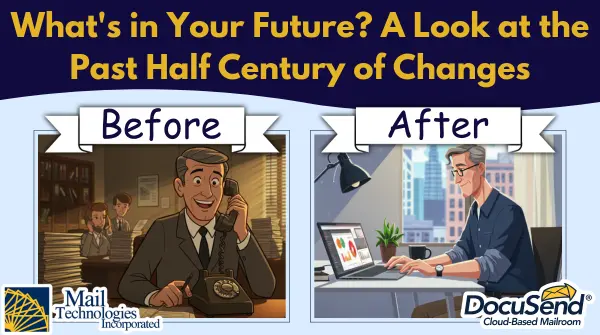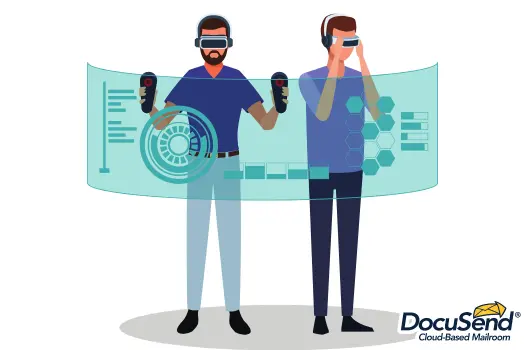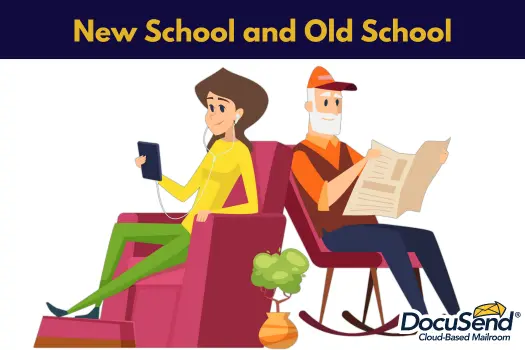What's in Your Future? A Look at the Past Half Century of Changes

Five Decades of Change
Life looked a lot different five and a half decades ago. In 1969, you had to dial phone numbers you looked up in a book provided by the phone company. Calling people who lived out of town required a bank loan if you talked too long. And no one even knew what an email address was.
A half-century later, technological advancements have put a computer in practically every home, cars drive themselves, and everyone over three years old needs a smartphone.
Many of these changes would not have been possible without the invention of the modern internet. Yes, the old www, the World Wide Web, the ecommerce highway. When it was first introduced in 1991, little did we suspect what an enormous impact it would have on coming generations.
By now, many of us take the extraordinary power of instant access to information for granted. That’s a little dependent on what generation you happen to be in, of course. But the potency of having these internet tools at our fingertips means we no longer spend long hours at the library combing through their encyclopedias and periodicals (remember the microfiche reader?) to make ourselves and others brainier, shrewder, or just plain happier.
Without the Past, the Future Has Little Relativity

We’ve all been there. You can’t appreciate what it’s like to be up until you’ve been down, right? One can’t truly enjoy an eighty-dollar steak unless one has downed a few greasy cheeseburgers first. Better to drive a 1991 Yugo before test driving a new Rolls Royce.
No matter what your chronological age, life is much different for people and businesses than it was fifty years ago. Hopefully, most of us get wiser as we get older by learning through our experiences. My wife tells me that if that’s true, I should be wise enough to be a genius by now. Don’t be fooled. Not everybody gets wiser as they age. Unlike ignorance, intelligence has its limit.
A Reminder of How We Got Here
Using data from the US Census Bureau, the Bureau of Labor Statistics, news reports, and Stacker.com, here’s a list of some of the ways our lives have changed over the past fifty years. And there’s a little tidbit at the end about what I learned from it that I hope might help a few people, particularly small business owners.
How Life Has Changed in the Last 55 Years
- Artificial Intelligence: AI was once the stuff of sci-fi. Now it's writing code, handling customer service, diagnosing diseases, creating art, doing predictive analytics for businesses, and even driving cars autonomously. It's transforming industries and raising ethical concerns around job displacement and safety along the way.
- Working Moms: In the seventies, only 11.6% of women from households with children contributed all or part of the family income. In 2024, the number had jumped to 74%, which includes both single and married mothers with children under the age of 18.
- Working Dads: In the mid-seventies, men spent less than an hour a day doing domestic chores. That number jumped significantly by 2025, to an average of 2 hours and 12 minutes per day.
- The Internet: In 1969, the US Department of Defense began using ARPANET, the Advanced Research Projects Agency Network, as the precursor to the modern internet. The public didn’t get the World Wide Web until 1991. Google launched in 1998, and now, as of April 2025, approximately 5.64 billion people worldwide are using the internet, representing about 68.7% of the global population. More than 60% of global website traffic is accessed via mobile devices.
- Home Computers: IBM released the first modern desktop computer in 1975. As of early 2025, 96% of households had either a desktop or a laptop, and 92% had an internet connection, for the most part a broadband subscription. Laptop orders surpassed desktops for the first time in 2008, and the trend is continuing. And for those who still need a desktop computer, these are getting smaller and smaller, with a mini PC that fits in your hand packing the same power as the clunky models.
- Television: Are you old enough to remember when there were only three major TV networks in the US: ABC, CBS, and NBC? Today, satellite and cable options offer hundreds of channels, including movie networks like HBO (launched in 1972) and music networks (1981).
- Entertainment: The first VHS tape came to America from Japan in 1977. The original VCR cost $1,280 (approximately $6,673 in 2025 in inflation-adjusted dollars). Consumers rented videos (and later DVDs) beginning in 1987. When Netflix was founded in 1997, it was a DVD-by-mail service that slowly disrupted traditional video rental chains, then evolved to a streaming platform by 2007 and became the pioneer of subscription-based services offering on-demand video content. YouTube, launched in 2005, became an important milestone in content creation and entertainment. Twitch, TikTok, and others followed. These platforms turn regular users into influencers, without the need to be a celebrity or have enough connections. It has given rise to a creator economy worth billions.
- Emails Send Letters Instantly: Before the proliferation of the internet, people wrote and mailed physical letters all the time. In 1996, Hotmail started a free email service that could send messages instantaneously. A year later, about 10 million people worldwide had an email address. But this number seems ridiculously small now, when 4.6 billion people use email. In recent years, though, people are increasingly leery of using it to receive invoices and other sensitive documents.
- Print Encyclopedias Replaced: Before Google and Wikipedia, kids thumbed through volumes of Encyclopedia Britannica or the World Book to get information for book reports or history projects. Now both are online. Britannica suspended printing in 2012, some say a long-overdue decision.
- Digital Books: There were no reading apps for smartphones, no Kindles, iPads, or other e-readers fifty years ago, just printed copies of books people carried around with them. In 2025 readers can consume their pages digitally, storing hundreds of books in one portable device. Physical books still far outsell e-books, though, making up 70.5% of total book sales.
- Landlines: Cell phones became common in the early 2000s. Now only some members of the older generations are more likely to hang on to their home phones. The majority of people have ditched landlines since then.
- Smartphones: Currently about 70.7% of people around the world have a smartphone. From 2007 to 2013, the smartphone saw double-digit sales growth. Since so many people now have smartphones – and are holding onto them for longer – sales decreased for the first time in 2017.
- People Connections: In the 1960s, people were much less connected. Getting someone on the phone meant ringing them up at home or at work, not on their commute in between. Since people constantly have their smartphones next to them, they're almost always reachable – which for some may not be a good thing, especially for introverts. Social media platforms like Facebook (2004), Twitter / X (2006), Instagram (2010), and TikTok (2018) have forever changed how people connect, share news, and do business. Not actively running any social media account is often considered weird. While they’ve helped maintain relationships, they’ve also contributed to rising anxiety and information overload.
- Print Newspapers Disappearing: Newspaper circulation peaked in the 1990s with more than 62 million US households receiving a paper on Sunday morning. After the rise of the internet and major declines in advertising, Sunday circulation dropped. Newsrooms have lost nearly half their reporters, editors, and photographers since 2004.
- TV Commercials Are Now Circumventable: With the development of DVR technology, which records live television, people can fast-forward through commercials. With the proliferation of subscription streaming services, viewers can avoid ads completely.
- More People Work Remotely: In the United States, remote work has continued to rise, with 36.2 million Americans, approximately 22% of the workforce, projected to work remotely by the end of 2025. Those who spend 60 to 80% of their time working away from the office have reported the highest levels of engagement.
- Data Storage: In 1971, IBM installed floppy disk drives into their computers, capable of storing 80 kilobytes. By 1986, the disk dimensions decreased, and the storage capacity increased to 1.44 megabytes. In 2018, Samsung created a 2.5-inch device that can hold 30 terabytes of storage—enough memory for 5,700 HD movies. Storage capacities have continued to soar. Additionally, cloud technologies have emerged. Many apps for business and everyday life are using cloud storage, making it possible to store virtually unlimited amounts of data. Cloud-based services have changed how people and businesses manage their daily tasks and collaborate. Whether you're sharing documents, storing vacation photos, or running a global team, you can access files and data anytime, from any device without the need for storage hardware.
- GPS to Guide Us: No more printed maps to help us find our way. But they haven’t completely disappeared, and that may be a good thing. There are studies that show our brain’s navigational functions can go dormant when we depend on digital directions too much.
- The ’Burbs: Only 13% of Americans lived in the suburbs before World War II. By 2010, more than half the population opted for homes outside the city. Young professionals and older Americans started bucking this trend beginning in 2014, moving back to the big cities. Pandemic lockdowns and greater opportunities for remote working reversed the flow yet again: In 2025, the trend is to move away from urban centers, driven by the desire for more space and fueled by the ability to work remotely. Plus, some retirees and older adults are moving from traditionally popular Sunbelt states back to the Midwest, seeking more affordable housing and a milder climate.
- Four-Legged Companions: Dog and cat ownership has quadrupled in the last fifty-plus years, with Americans expected to spend an all-time high of $157 billion on their pets in 2025.
- Alternatives to Expensive Housing: Incomes have not risen at the same pace as home values. Compared to the ’70s, renters are waiting twice as long to buy a home, with the average age of 38 for first-time home buyers, and 58 for those purchasing a home after already owning one.
- American Women and Credit Cards: Believe it or not, unmarried women in the US were not allowed to get a credit card until the Equal Credit Opportunity Act was passed in 1974. And before that, married women had to have their husbands cosign their application to get one.
- When We Marry: In 1960, 72% of people 18 and older were married. Only about half of adults are married now. On average, today people get married much later than they used to, women by 28 years old, and men at 30.
- Music Unlimited: In 1979, people could take their music with them for the first time, with the Sony Walkman. Between 1987 and 1997, the popular device led to a 30% increase in the number of people who said they walked for exercise. Cassette tapes gave way to CDs in the ’90s, which could be listened to on the go with a Discman. Apple's iPod debuted in 2001. And now with services like Spotify and SiriusXM, people have unlimited access to music through their smartphones.
- Banking: In the digital age, people can deposit or transfer funds and make payments right on their computers or smartphone apps. They can also use ATMs instead of a brick-and-mortar bank. Physical branches of banks are still needed as an option, but mostly for services other than transferring funds.
- Digital Payments: From PayPal to Apple Pay to Wise, digital payment systems now power online shopping and peer-to-peer transactions. It fueled the freelance work tendency and made it easier than ever to work and get paid from anywhere in the world and reach a more flexible lifestyle.
- Driving Automobiles: We don’t have flying cars yet, but self-drivers are a reality. They may still have issues, but many believe they’ll be safer in the long run for everyone.
- Who Needs a Car? A lot of millennials and Gen Zers don’t think they do. They are urbanites and suburbanites who are foregoing car ownership entirely in favor of ride-sharing services like Uber and Lyft. Many claim they simply don’t need a car. In cities like New York, San Francisco, and DC, over half of young adults don’t own cars.
- Modern Depression: Depression was considered a rare condition fifty years ago. Prozac didn’t even exist until 1987. But over the last few decades, it has become the leading cause of disability. And teenagers are reporting more anxiety than at any other time in history.
- Retirement: As recently as 1985, 10% of Americans age 65 or older reported that they were working or looking for work. That number rose to 19.2% in 2025. People are putting off retirement because they are living longer and also due to a lack of social benefits and financial stability.


What Do We Need This Information For?
Not everything is better because of technology. Some things were actually simpler to do fifty years ago.
Consider these examples:
It was easier to meet new people because people didn’t rely on their phones to communicate. In the age of smartphones, meeting someone organically can be much more difficult. But fifty years ago, it was practically the only way to make a new acquaintance.
You could choose to stay off the grid fifty years ago. With social media, geotags, GPS, electronic financial transactions, smart devices, surveillance cameras, online shopping habits, and even data collected by search engines, it’s pretty difficult to delete your digital footprint nowadays.
Working was more personal when it was less reliant on technology. Without question, our lives have benefited overall, but some are so reliant on tech, they send emails to colleagues they work in plain sight of.
Air travel didn’t require the TSA, and getting through security was a breeze. You could take a lot more items on a plane. Even scissors and baseball bats were allowed, and people didn’t have to worry why.
Political issues now spring from social media as political discourse in the United States has increasingly been influenced from abroad. Russia placed thousands of fabricated content pieces on social media to sow discord during our 2024 elections. And they were followed up with hundreds of fake accounts designed to amplify these messages.
Before the 1970s, most families had only one income. Today, half of couples living together have a dual income.
Buying a home was much easier. In 1960, the median home cost $11,900 with a household median income of $11,900. In 1980, that same house cost $47,000 with a median income of $17,710. As of the first quarter of 2025, the median sales price for US homes is $416,900. Meanwhile, the median weekly earnings for full-time wage and salary workers are approximately $1,194, which annualizes to about $62,088.
Technology and the Future: Where Do We Go from Here?
My grandmother used to say, “You can understand life better by looking back at the past, but to live a good life, you must look forward to the future.” And that says it all, doesn’t it?
So here we go into our future, using technology to shape it and make it better!
The bottom line here is that technology has drastically improved the overall quality of life. It has undoubtedly made our day-to-day tasks much simpler and more hassle-free. The more it advances, the more information is available to improve our lives. Innovative software and advanced technology, when used wisely, help us break bad habits and establish better ones.
Fifty years ago, it was difficult to acquire information without looking through multiple books to understand even the most rudimentary concepts of the answers we were seeking. There is no question that the vast amount of information easily available on the internet enriches every aspect of our lives.
To name a few of them:
Better medical procedures, identifying and kicking bad health habits, longer life expectancy, more efficient and reliable machines, safer air travel, and the ability to better feed the world’s growing population. The important thing to remember is that we need to make the right choices to use technology to our benefit. And that’s not always as easy as it sounds.
Conclusions
Be discriminating between technologies that work to your advantage and ones that should be rejected. If you think that requires some thought, you’re right. But it will pay off. I guarantee it. My own small but worth-mentioning contribution is DocuSend. All it does is save SMB owners from spending hours doing the menial tasks associated with manually mailing their invoices, documents, and customer communications. But if you spend those hours with your kids or taking your spouse to dinner or making your business grow, then it must be the kind of technology that makes our world just a little better. Try it and let me know what you think. It was invented by a wonderful team of experts that had your business in mind. It’s the best cloud-based mailroom service out there.

